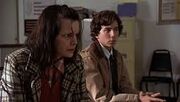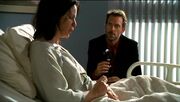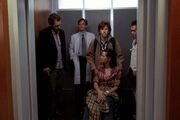This article is about the schizophrenic patient in the episode The Socratic Method. For the young girl patient in the episode Act Your Age, see Lucy.
- House: "Lucy! I don't think you're crazy."
- Lucy: "Neither do I. But I'm crazy."
- — The Socratic Method
Lucy Palmeiro is the schizophrenic patient in the episode The Socratic Method. She is portrayed by actress Stacy Edwards.
Medical History[]
The patient was diagnosed with schizophrenia one year previously and had lost her employment as a result of her deteriorating condition. She was living with her young adult son and receiving social assistance. She suffered from paranoia and auditory hallucinations.
Case History[]

The patient was admitted to the Princeton-Plainsboro Teaching Hospital emergency room after collapsing from respiratory arrest in the social assistance office with extreme pain in her right leg and chest. The paramedics intubated and reported poor blood oxygenation. She was stabilized and diagnosed with a pulmonary embolism as a result of clotting from a deep-vein thrombosis. The former had caused the respiratory arrest and chest pain, the latter the leg pain. She was put on blood thinners and was ready for discharge. Dr. Wells asked the patient's son why her blood alcohol level was .12 at 10:30 AM. The son admitted that he had let her mother have a small drink before going to the social welfare office in order to keep her calm. However, he claims that he only gives the mother alcohol occasionally. Dr. Wells believed that the deep-vein thrombosis was the result of long periods of immobility as a result of alcoholism. However, the son denied she was an alcoholic and said there had to be another explanation for the thrombosis.
Dr. House, who had been in the ER waiting room, challenged the attending conclusions, wondering if Dr. Wells scoped for varices and checked the esophagus to confirm alcoholism. Dr. Wells agreed to assign the case to Dr. House.
Dr. House asked his team what would account for the thrombosis in a patient with no previous history of clotting. Dr. Foreman pointed out that smoking, obesity and diabetes could all cause a thrombosis. However, Dr. House pointed out that thromboses rarely affect people until their late fifties and the patient was only thirty-eight. Dr. Foreman suggested an injury, but Dr. House pointed out there was no trauma, or indeed any other risk factor. Although the patient was schizophrenic, that too was not a factor in blood clots.
- Foreman: "He's really talking to a patient?"
- Chase: "I don't know who I am anymore."
- — The Socratic Method

House with Lucy Palmeiro
Dr. House went to visit the patient and asked the patient's son to leave. He asked the patient about her alcohol intake and her previous medication history. She denied having any previous leg pain. She also denied ever lying to her son. He also noticed that the patient had stopped shaving her legs because her tremors were getting worse. Dr. House ordered a blood panel for clotting factors, PT, PTT, Factor V, protein C, and protein S. He also ordered her schizophrenia medication discontinued to see if that was causing her underlying problems.
Dr. Foreman tried to take blood, but the patient resisted. Dr. Foreman ordered haldol to sedate her. Her son complained about it to Dr. House because she complains about the effect it has on her.
The patient started vomiting blood. Dr. House confronted Dr. Foreman about using haldol when he was specifically told not to put her on any other medication. Dr. Foreman argued that the side effects of haldol are rare, but Dr. House pointed out the side effects - depression, confusion, and unconsciousness, are exactly the issues he is trying to rule out by taking her off medication. Dr. House argued that Dr. Foreman should have used physical restraints before resorting to a sedative. Dr. Cameron reported the clotting studies were normal. The only abnormal result was a prolonged PT time, and Dr. Foreman had to admit that this result usually only happens when the person who drew the blood, himself in this case, did it incorrectly. However, Dr. House did not believe that Dr. Foreman had screwed up and instead chose to believe the PT study was correct. The most likely cause was Vitamin K deficiency. This would cause Protein C deficiency and without Protein C, she would be having a lot of clotting. Dr. Cameron suggested that it might be a drug interation between heparin and ampicillin, but Dr. House pointed out she wasn't on ampicillin. However, Dr. Cameron pointed out that she had been prescribed ampicillin for a sore throat. However, the patient said she refused to take the pills and Dr. House believed her. Dr. Chase said that scurvy was far more likely than Vitamin K deficiency, and he thought it was just alcohol in any case. That would explain the thrombosis, the bleeding, and the prolonged PT time. Dr. House ordered an environmental scan for antibiotics and diet, and then an ultrasound of her liver.
Dr. Foreman and Dr. Chase performed the scan of the patient's apartment. In addition to her psych medications, they found an untouched bottle of ampicillin. However, when they went to the freezer, they found it full of nothing but prepared frozen hamburgers, which contained absolutely no Vitamin K. The son told Dr. House it was the only thing that his mother would eat, but Dr. House informed him about the lack of Vitamin K in her diet. She was put on supplements. However, Dr. Chase was not convinced that the vitamin deficiency was the patient's only problem.
Dr. House guessed the son wasn't 18, but had just turned 15. He tried to convince the son to go into foster care, but he resisted.
Dr. House put the patient on a sedative. Dr. Chase performed an ultrasound on her liver and found a tumor - a solid mass that was almost certainly cancer. This is what was causing the bleeding. Dr. Wilson was called in for a consult and spoke to the patient and the son. The tumor was large - 5.8 centimeters. If they did nothing, her prognosis was death within sixty days. The patient was not eligible for a liver transplant because of her indigence, history of alcohol use and mental condition. Dr. House suggested a surgery to resect the tumor. Dr. Chase suggested using Dr. Bergen as he was skilled in Gamma Knife radiosurgery, which would allow resection that would save as much of the liver as possible. However, the tumor's size ruled out surgery as it was larger than the surgical guidelines allow. Dr. House decided to have Dr. Wilson and Dr. Cameron inject the tumor with a solution of 25% ethanol. This would dry out the tumor and shrink it to 4.6 centimeters, just within the surgical guidelines.
However, after a seemingly casual conversation with Dr. House, Dr. Cuddy became suspicious and reviewed his charts. She found out about the shrinking tumor and the ethanol. However, she did not inform Dr. Bergen. Dr. House ordered Dr. Cameron to assist with the surgery. Dr. Bergen found out about the ethanol, but continued with the surgery in any case. Dr. Cameron apologized on his behalf. The surgery removed most of the tumor, but the patient had to be started on chemotherapy as well.
Dr. Chase talked to the son about the patient's alcohol abuse, but the son denied his mother abused alcohol despite the liver problems. However, child services came to remove him to a foster home. He accused Dr. House of calling children's services. However, Dr. House hadn't done it and as the patient was the only person who knew, he started to have doubts about whether the patient was mentally ill. He went to the patient, who denied it. However, he checked the phone records, and there was only one call from her room - to children's services.
Dr. House pointed out that schizophrenics cannot make major decisions like self-sacrifice. He also noted that the symptoms didn't present until she was 37, rather late for schizophrenia which usually presents by the age of 25. He also noted that her thought processes got clearer when she was off medication. Late one night, he started calling around to all her previous doctors, generally getting the brush off because of the late hour. He gets his team together and notes that specialists generally only pick a disease that is within their specialty. The patient received a schizophrenia diagnosis because she went to psychiatrist. He asked what other diseases could explain the symptoms. Dr. Cameron suggested porphyria or it could be a genetic disease that results in too much copper in the body. Dr. Chase noted the latter was Wilson's disease. Dr. House noted that the patient didn't show up for an appointment with a doctor. Dr. Cameron thought it was a psychiatrist, but it was in fact an opthamologist. In addition to causing cirrhosis, it also presents with cataracts and a copper toned ring in the cornea of the eye - Kaiser-Fleisher rings. They gave the patient an ophtamology exam and found the ring surrounding her iris. They started her on treatment. She slowly improved and was soon well enough to be released from the hospital.

- "I will talk no more of books or the long war / But walk by the dry thorn until I have found/ Some beggar sheltering from the wind, and there/ Manage the talk until her name come round./ If there be rags enough he will know her name/ And be well pleased remembering it, for in the old days/ Though she had young men's praise and old men's blame/ Among the poor both the old and young gave her praise."
- ―Lucy, quoting "Her Praise" by W.B. Yeats.
A reflection of House[]
Like most of the patients in the series, Lucy represents a part of House, in this case, the misdiagnosed patient who was left to deteriorate from the disease. Like House, she was receiving medical attention and treatment, but continued to get worse. She was at the mercy of doctor who jumped to the "horse" diagnosis (in this case, schizophrenia and alcoholism) when in fact she had a zebra. Her case is like House's in slow motion. Wilson's disease causes permanent damage if it is left undiagnosed for a lengthy period of time, but like House's infarction, if caught quickly enough, it would have been easy to treat. In this case, again like House's, the Wilson's led to complications - liver cancer, clots, and even indirectly to her dietary deficiencies.
Reaching the diagnosis[]
A lot of reviews of the episode discussed just how hard it would be to diagnose Wilson's disease. House medical blog Polite Dissent was a bit incredulous. Although Wilson's is a big zebra (it's very rare), it is also a "med school disease", one that almost every medical student is familiar with despite it's rarity. He couldn't belive that several doctors would all have missed it.
However, studies have shown that, in real life, Wilson's is often difficult to diagnose. A study of Wilson's patients showed that almost half of them had either been diagnosed with another condition or received no diagnosis at all before reaching the doctor who diagnosed them with Wilson's. In fact, the differential diagnosis for a possible case of schizophrenia requires ruling out Wilson's, but conversely, a diagnosis of Wilson's on the basis of neurological symptoms like Lucy's would require ruling on schizophrenia. In fact, there is a case in the medical literature of a young Wilson's patient being mistakenly diagnosed with schizophrenia.
The truth is, the early symptoms of Wilson's are prosaic, which is why it is properly classified as a zebra - not only is it rare, but the symptoms it does cause even in advanced cases are far more liklely to be caused by some other illness. Even Kayser-Fleischer rings are not definitive - they can be caused by conditions that merely obstruct the bile ducts
That being said, the onset of schizophrenia in a 37 year old is unheard of. It is rare that it will manifest for the first time in a 25 year old, and usually hits fairly early in adulthood. House was right to be skeptical about the schizophrenia. Like another patient named Lucy, this Lucy was exhibiting diseases that didn't match her age - too old for schizophrenia and too young for a deep vein thrombosis.
Explaining the medicine[]
- A blood alcohol level of .12 (120 milligrams of alcohol in 100 millilitres of blood) would be typical for a person who had had the equivalent of one shot of 80 proof alcohol. It's well above the legal limit for driving, which tops out at .08 to .10 depending on the jurisdiction.
- House questioned Dr. Wells' diagnosis of alcoholism, which could be confirmed by examining the veins inside the patient's esophagus. In alcoholics, they are notably dilated (although the dilation can be caused by any type of liver damage). Wells' response showed that he had not checked for this obvious sign and had jumped to conclusions.
- There are several proteins or "factors" involved in the clotting of blood, the shortage or abundance of any one of which can cause blood to clot more quickly or more slowly. House's blood tests focussed on these clotting factors to see if they were within normal range.
- Discontinuing the schizophrenia medication was not very risky. The only effect would be to exacerbate Lucy's symptoms and, in a hospital setting, she was likely not to suffer any adverse effects.
- Vitamin K deficiency is almost as big a zebra as Wilson's disease here. The body doesn't need a lot of Vitamin K, there's usually a large reserve held in the body's fat, and it's available in a large variety of foods. Had Lucy taken lettuce on her burgers, she would have gotten plenty.
- Dr. Bergen's likely refusal to operate if the tumor is over 5cm in diameter is warranted. 5 cm separates stage II cancers from stage IIIa cancers. Resection (removal) is very likley successful in a stage II tumor, but there are likely to be life threatening complications both during and after surgery with a stage IIIa tumor. It's very likely that too much of the liver would have to be removed for the patient to survive long after surgery.
Character relationships[]
- Mother of Luke Palmeiro
This article was the featured article for May, 2014. It was the first featured article for a patient.
| Season 1 | |||||
| #01 | "Pilot" | #09 | "DNR" | #17 | "Role Model" |
| #02 | "Paternity" | #10 | "Histories" | #18 | "Babies & Bathwater" |
| #03 | "Occam's Razor" | #11 | "Detox" | #19 | "Kids" |
| #04 | "Maternity" | #12 | "Sports Medicine" | #20 | "Love Hurts" |
| #05 | "Damned If You Do" | #13 | "Cursed" | #21 | "Three Stories" |
| #06 | "The Socratic Method" | #14 | "Control" | #22 | "Honeymoon" |
| #07 | "Fidelity" | #15 | "Mob Rules" | ||
| #08 | "Poison" | #16 | "Heavy" | ||
| Featured articles | ||
| April 2014 | May 2014 | June 2014 |
| Love is Blind | Lucy Palmeiro | Olivia Wilde |
